Japanese Buddhist Temple Design

I have taken photos of this temple many times but as the lens of my eyes become more trained and creative, I find pleasure in re-clicking at these historical buildings as if seeing them for the first time. At each session, new details are revealed.
Japanese Buddhist architecture consist of variants originating in China. In the 6th century after Buddhism arrived in Japan via the Three Kingdoms of Korea an effort was made to have a standardized temple representing the faith.
Over time the temples were built to suite Japanese taste and the unique weather conditions such as high humidity in the summer, the rainy season (June 15-July 15) and long cold winters.

Onigawara -鬼瓦 Demon Tile
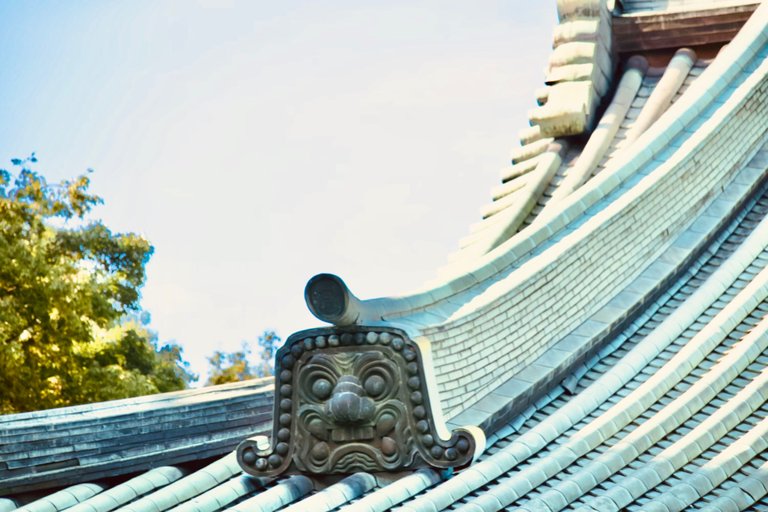
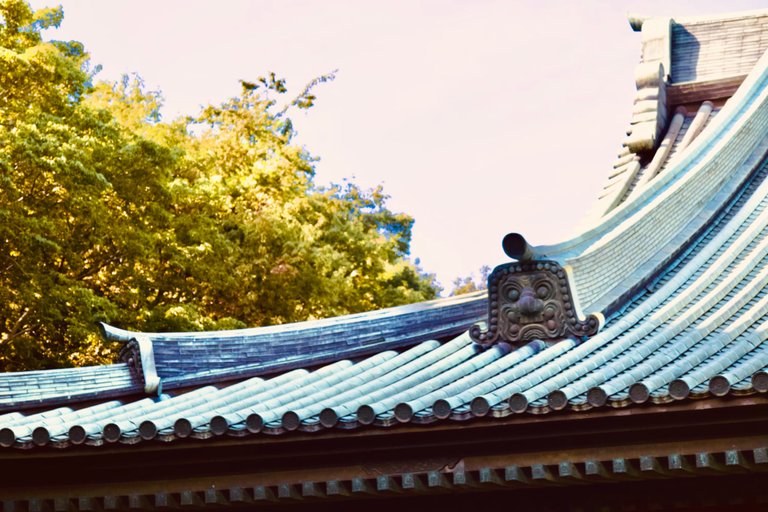
On this smaller building to the right of the temple, we can also see an Onigawara. In the foreground we see a Tōrō which is a lantern. We can see Tōrō of various designs in many places in Japan but of course they are no longer used to light up the night. When you think about it, why the elaborate design for a lantern? I am not sure but by the looks of it, it kept the fire in place, wind proof and away from wooden structures that most temples in Japan are made from. There is probably a more symbolic meaning behind the design but that will take some research for another time.
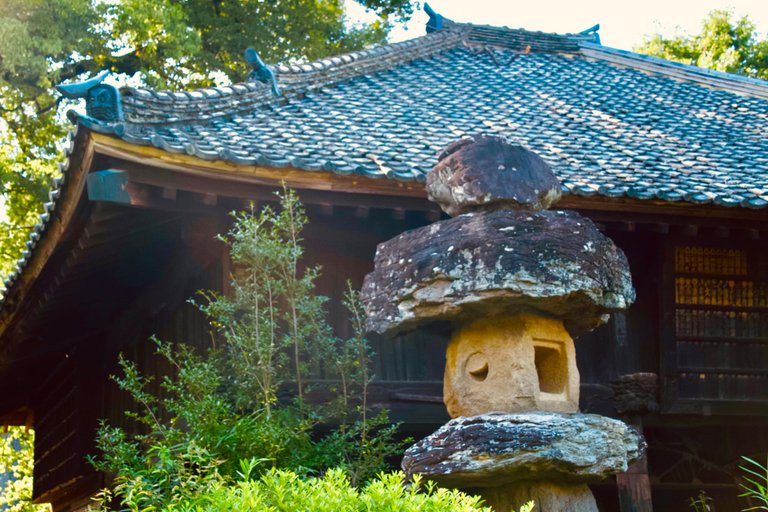
Buddha statue in the garden of the temple. In front of him, a dragon guarding an incense alter. As I took this picture I couldn't help feel a sense of peace and calm and stood for a second to meditate myself.
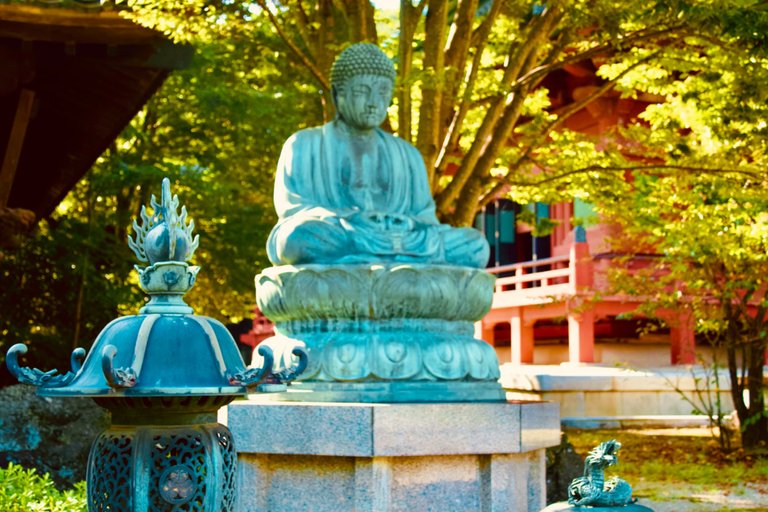
This is called Chōzu-ya or temizu-ya and is used to purify the hands and spirit with water before entering to pray at the shrine or temple.In the background we can see the Buddha statue. On all the buildings, the roof design has that slight distinctive curve.
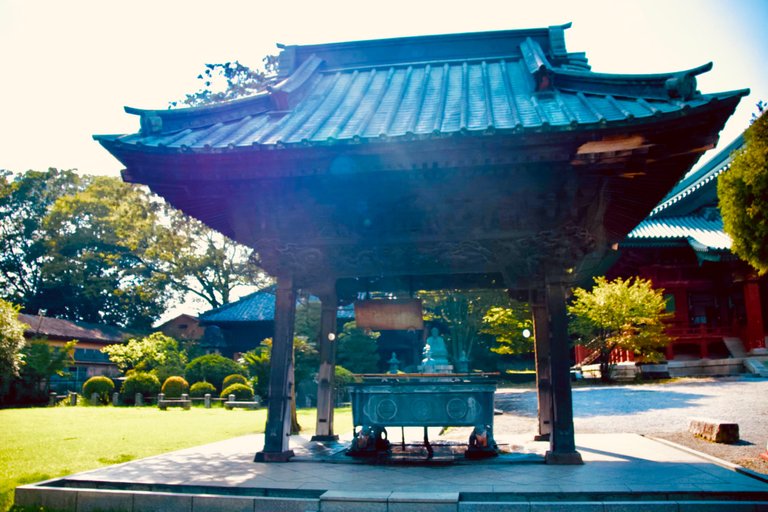
Again, on this bell 🔔 tower in the picture below, we can see the same curve. The bell towers are called Bonshō ( 梵鐘 ) or Buddhist bells, they are also called tsurigane. They are used to summon the monks for prayer, segment periods of time and also used to welcome the new year.
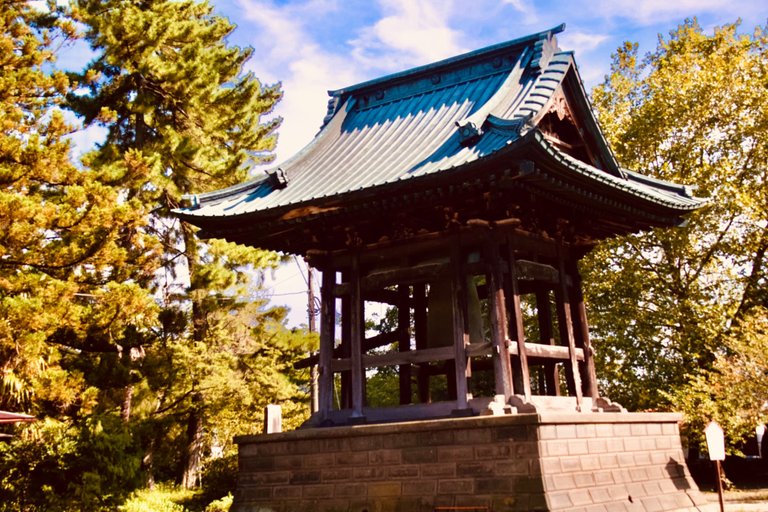
The last picture below is of the underneath of the main temple building’s roof. You can see the symmetry and detail of the work put into it. The roof of the temple is the feature that makes it truly stand out. From the curves, well placed tiles, demon carvings and symmetry, these cultural beauties with long history brings awe to its beholder.
Thank you for reading & hope you enjoyed this journey to the temples.
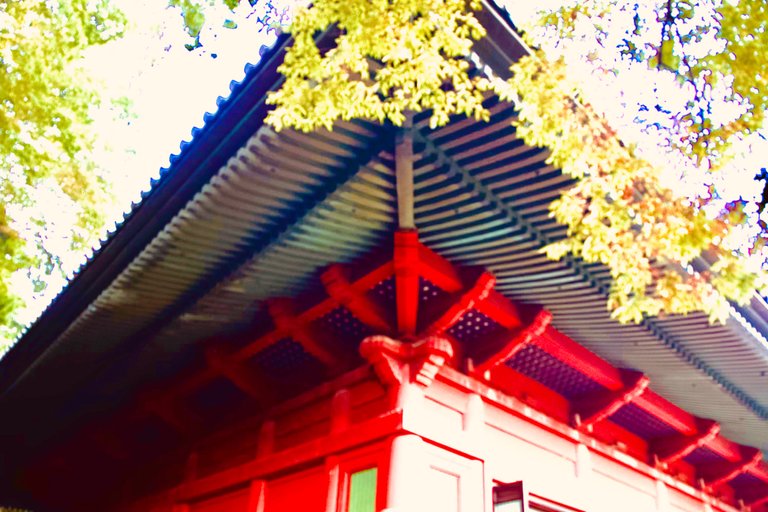
Location: Daikon Buddhist Temple, Gunma, Japan.
Camera: Canon M50
Electronic-terrorism, voice to skull and neuro monitoring on Hive and Steem. You can ignore this, but your going to wish you didnt soon. This is happening whether you believe it or not. https://ecency.com/fyrstikken/@fairandbalanced/i-am-the-only-motherfucker-on-the-internet-pointing-to-a-direct-source-for-voice-to-skull-electronic-terrorism
Electronic-terrorism, voice to skull and neuro monitoring on Hive and Steem. You can ignore this, but your going to wish you didnt soon. This is happening whether you believe it or not. https://ecency.com/fyrstikken/@fairandbalanced/i-am-the-only-motherfucker-on-the-internet-pointing-to-a-direct-source-for-voice-to-skull-electronic-terrorism
https://twitter.com/depaiso/status/1432902692125360133
The rewards earned on this comment will go directly to the person sharing the post on Twitter as long as they are registered with @poshtoken. Sign up at https://hiveposh.com.
Good one here
Hello @dmilliz, I really enjoyed reading your post. There's something meditative about it as well.
We studied different types of historical and architectural styles back in school but back then we were just forced to cram all the terms and images in our head that we tend to forget after many years.
Your post is a breath of fresh air. I was able to absorb and remember and it makes one wonder why an onigawara, a demon tile is used to repel evil away from temples.
Welcome to A+D Community!
Thanks for the great comment and welcome.
Yeah, school is like a preview I can imagine, no time to teach it all. Glad my post brought back some lessons/memories.
The Onigawara can be very creepy, I think they scare off more than evil spirits as I never see birds land on the roof of temples 😂
Japanese structures never failed to amaze me and whenever I see photo of them they make me want to travel to Japan.
Indeed! Can’t get tired of seeing them. A mystical piece of art and history, see you in Japan one day soon.
This temple looks really beautiful. Here in my region, buildings with similar shape as of the Buddhist temple is common. Mainly this is because we live close to Himalayan mountains and our region falls under seismic zone. Japan is also prone to earthquakes and i guess this shape is to help reduce the destruction a little
The Buddhists seem to favor these types of shapes. Would be interesting to hear how it all started. Maybe it has something to do with the shape of the body on the meditation pose.
Regarding earthquakes, I think this os the reason that temples are made of wood here as they can bend and bow to the shakes of the quake. Let's hope now big ones soon.
Very cool photos! Those temples are really something! 😎
Thank!!! I think I might be taking ore architecture shots in the days ahead. What ever happened with those flight tickets?
They were cancelled and they returned the money 18 months later. 🙄
My God, it's been that long!
Greetings @dmilliz. We were just conversing in my latest post on Kuala Lumpur and here you are now, posting your awesome architectural story. So, it's with pleasure that I warmly welcome you to the Architecture+Design Community.
Buddhist temples in Japan have an enchanting allure to them, and whether or not you're religious, they possess a defining sense of enlightenment (Zen) in their distinctive architecture. The real glory is in their elaborate details, and this is what sets the Japanese people apart from the rest of the world. Being highly gifted creatives, craftsmen, and builders, they never cease to amaze us. Thanks a lot for your interest in our tribe.
Thanks for the warm welcome. Yes, that post on Kuala Lumpur was awesome. Well written and captivating. It inspired me to actually post in this community. I also like to explore the various tribes and contribute to things that interest me.
You have a way with words man. I could have described the allure of the temples any better. The Japanese are very meticulous and it is seen in anything they build. You have to truly respect their work ethic. I plan to take more photos of Japanese design and architecture as I have gained a new interest. Been looking at many houses and appartements as I’m trying to figure an investment property.
Stay blessed and thanks for the support.
I'm truly humbled by your sincerity and compliment. And as much as this community continues to elevate architecture and design with the Hive blockchain, we absolutely take pride in receiving remarkable creators like you. Many thanks again man, and I'm simply excited to experience your upcoming publications here. Cheers! 😊
Thank you for sharing this amazing post on HIVE!
Your content got selected by our fellow curator @priyanarc & you just received a little thank you via an upvote from our non-profit curation initiative!
You will be featured in one of our recurring curation compilations and on our pinterest boards! Both are aiming to offer you a stage to widen your audience within and outside of the DIY scene of hive.
Join the official DIYHub community on HIVE and show us more of your amazing work and feel free to connect with us and other DIYers via our discord server: https://discord.gg/mY5uCfQ !
If you want to support our goal to motivate other DIY/art/music/homesteading/... creators just delegate to us and earn 100% of your curation rewards!
Stay creative & hive on!
Congratulations @dmilliz! You received a personal badge!
You can view your badges on your board and compare yourself to others in the Ranking
Check out the last post from @hivebuzz:
Well done @dmilliz! We're happy to inform you that this publication was specially curated and awarded RUNNER-UP in Architecture Brew #37. Congratulations!
Subscribe to Architecture+Design, an OCD incubated community on the Hive blockchain.